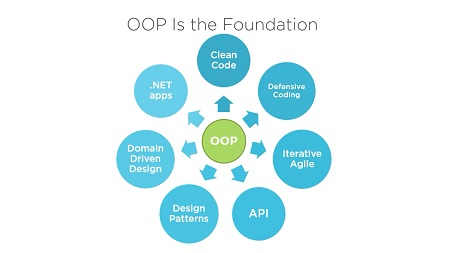
English | MP4 | AVC 1280×720 | AAC 44KHz 2ch | 3h 26m | 450 MB
This course takes you, step by step, through the principles and practices of object-oriented programming (OOP). The course provides you with the firm foundation in OOP that you need to progress to intermediate-level C# courses.
This course takes you through the principles and practices of object-oriented programming (OOP). The course provides you with the firm foundation in OOP that you need to progress to intermediate-level C# courses. It begins by showing you how to turn a set of words into a set of well-defined and related classes. Through demonstrations, it teaches you key object-oriented concepts such as abstraction, encapsulation, inheritance, polymorphism, and interfaces.
Table of Contents
Course Overview
1 Course Overview
Introduction
2 Introduction
3 Object != Class
4 Terms in Context
5 What Is Object-oriented Programming
6 Get the Most from This Course
7 Course Outline
Identifying Classes from Requirements
8 Introduction
9 Analyze the Business Problem
10 Start with the Nouns
11 Define Appropriate Members
12 Consider Time
13 Abstraction
14 Encapsulation
15 Summary
Building Entity Classes
16 Introduction
17 Layering the Application
18 Building the Business Logic Layer Component
19 Building a Class – Properties
20 Using Snippets
21 Testing the Class
22 Testing the Class – Valid Values
23 Testing the Class – Invalid Values
24 Working with Objects
25 Objects Are Reference Types
26 Static Modifier
27 Checklists and Summary
Building Entity Classes – Methods
28 Introduction
29 Building a Class – Methods
30 Testing the Methods
31 Terms
32 Building a Class – Constructors
33 Building the Remaining Classes
34 Checklists and Summary
Separation of Responsibilities
35 Introduction
36 Separation of Concerns
37 Revisiting the Class Diagram
38 Building the Address Class
39 Building a Repository Class
40 Testing a Repository Class
41 Building the Remaining Repositories
42 Checklists and Summary
Establishing Relationships
43 Introduction
44 Defining the Relationships
45 Types of Relationships
46 Collaboration
47 Composition
48 Composition – References
49 Populating the Referenced Objects
50 Testing a Composition Relationship
51 Composition – Ids
52 Inheritance
53 Checklists and Summary
Leveraging Reuse through Inheritance
54 Introduction
55 Secrets of Reuse
56 The .NET Object Class
57 Overriding Base Class Functionality
58 Polymorphism
59 Building a Base Class
60 Demo – Building a Base Class
61 Preparing Overridable Base Class Members
62 Checklists and Summary
Building Reusable Components
63 Introduction
64 Scenario
65 Building a Reusable Component
66 Testing the Reusable Component
67 Using the Reusable Component
68 Static Classes
69 Extension Methods
70 Static Method vs. Extension Method
71 Checklists and Summary
Understanding Interfaces
72 Introduction
73 Class Interface
74 Interface Metaphors
75 Setting up the Demo
76 Defining an Interface
77 Implementing an Interface
78 Interface-based Polymorphism
79 Checklists and Summary
Final Words and Next Steps
80 Introduction
81 Recap
82 Next Steps
Resolve the captcha to access the links!